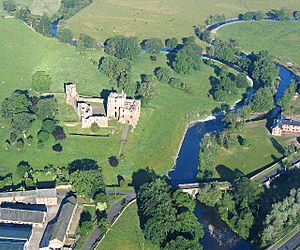Brocavum facts for kids
Brocavum was the Roman name for an ancient fort located near Brougham in Cumbria, England. Today, you can still see parts of the fort as mounds of earth. So far, archaeologists haven't dug them up to learn more.
Contents
Where Was Brocavum Located?
The Roman fort of Brocavum was built in a very smart spot. It had natural protection because the River Eamont and River Lowther flowed nearby, meeting to the west. This made it harder for enemies to attack.
Roman Roads and Settlements
Brocavum was also important because several major Roman roads met there. Imagine it as a busy highway intersection of its time!
- One road connected it to York and other forts like Brough under Stainmore and Kirkby Thore. This route is now similar to the A66 road.
- Another road came from places like Manchester and Lancaster. Today, this path is close to the West Coast railway line.
- A third road linked Brocavum to the Roman port of Ravenglass and other forts like Galava (Ambleside).
From Brocavum, a road also went north to Luguvallium (Carlisle). This shows how central the fort was to Roman travel and control in the area.
Besides the fort, there was also a civilian settlement, called a vicus by the Romans. This was like a small town where people who weren't soldiers lived and worked. In 2008, parts of this settlement were found during a pipeline construction. A cemetery was also discovered in the 1960s. Bones from the cemetery suggested that some people living there might have come from Eastern Europe.
Local Beliefs and Tribes
Archaeologists found six special carvings dedicated to a local god named Belatucadrus at Brocavum. This suggests that people in the area really focused their worship on him. It's also thought that the Carvetii, a local tribe before and during Roman times, might have had their main gathering place nearby. These local connections, along with the rivers and roads, probably helped the Romans decide to build their fort exactly where they did.
When Was the Fort Built?
It's not totally clear exactly when Brocavum was built, but experts think it was important from early on. It might have been built soon after a local revolt in the early 70s AD. It was likely used during the early Flavian Dynasty (a period of Roman emperors starting in the 80s AD). Even though some items found in the cemetery were from later centuries, the fort itself seems to have been active much earlier.
Brocavum Today: Castle and Conservation
Today, parts of the Roman fort are covered by the medieval Brougham Castle. This castle was built much later, during the Middle Ages. You can even see stones from the old Roman fort used in the castle's walls! For example, a Roman tombstone was reused as a ceiling slab inside the castle's main tower, called the keep.
The site of the Roman fort and Brougham Castle are both protected as an Ancient Monument. This means they are important historical sites that are carefully looked after. English Heritage is the organization that takes care of them, making sure they are preserved for future generations to learn from and enjoy.


